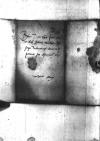⌊⌋ Vestrae Amplissimae Dignitatis, quibus me dignata est, mihi fuere gratissimae non minus, quod gratiam et favorem quendam erga me Vestrae Amplissimae Dignitatis redolere videbantur, quam quod a tanto praesule missae fuerint. Quibus quod tumultuarie respondeo, meis occupationibus adscribere dignetur, rogo. Quod commendatio et petitio mea veniam deliquenti puero impetraverit, non possum mihi hoc nomine gratulari, non minus et ⌊Ioanni⌋ ex Vestra Amplissima Dignitate ex patrueli nepoti, quod Vestra Amplissima Dignitas ipsius culpae oblita eum in gratiam suam resumere est dignata. In quo instituendo tam ad honestatem, quam ad bonas litteras meam operam Vestrae Amplissimae Dignitati gratificandi causa non intermittam.
Nova, quae Vestrae Amplissimae Dignitatis scientia digna esse existimem, prorsus nulla sunt, praeter haec domestica. Civis et consul quidam Cracoviensis ⌊Conopnyczki⌋, qui aere alieno multo erat obstrictus quique autumno praeterito in ⌊Moldaviam⌋ susceperat quingentes pedites, tuncque amentia quadam erat correptus, ratione tandem recuperata Sabbato Magno sub meridiem, ablegatis a se suis filiis, in collo(?) Bernardinorum, quo causa devotionis in illud triduum commigraverat, laqueo vitam finivit, sepultus nocte secunda, utique in coemeterii orig. ciniterii⌈coemeteriicoemeterii orig. ciniterii⌉ angulo. Dominus doctor ⌊Rawa⌋ [m]edicus on the margin⌈m hidden by binding⌈[m]m hidden by binding⌉edicus[m]edicus on the margin⌉, gentilis et patronus meus, feria secunda post Dominicam Conductus Paschae morbo quodam ex quartana febre contracto interiit, sepultus honorifice in sacello Praedicatorum, quod illi Capitulare vocant. Reliquit autem pecuniae duo circiter milia flor(enos), quam inter cognatos et pauperes distrahendam executoribus commisit.
Sabbato demum sequenti ⌊Malcherowa⌋, civis Cracoviensis, quae ad iudaismum a fide nostra desciverat nec resipiscere volebat, igne est absumpta, quamvis eam fidem haberet, quod ex igne illaesa d(ebe)ret exire.
In crastino ⌊coniunx⌋ magnifici domini palatini Cracoviensis, quam ⌊ille⌋, licet sterilem, sibi caram habebat, mortem obiit. Quae nudius tertius est in arce sepulta.
Reverendissimum ⌊praesulem Posnaniensem⌋ febre quadam, quam ille ex pane piperato a venatione rediens cum quodam liquore sumpto, dum nondum parato(?)s cibos ostendisset, contraxerat, nihilque faciebat(?), migrasse ad superos certissimum est. Illi sufficiendum quidam dominum episcopum Przemisliensem, qui non pridem ex ⌊Ungaria⌋ rediit, quidam Chelmensem dominum ⌊Branyczky⌋ opinantur.
⌊Reverendissimus noster Cracoviensis⌋ perendie in ⌊Pyotrkoviam⌋, ubi synodus feria sexta ante Penthecostes celebrabitur, profecturus est.
⌊Turcarum⌋ nulla imminere pericula et nostro et Ungarorum dominiis, dominus canonicus ⌊Byelynsky⌋ et ⌊castellanus Polanyecen(sis)⌋, qui in ⌊Ungariam⌋ foederis pacti confirmandi cum novo palatino gratia missi hodie redierunt, certe affirmant, licet et id ante unum et alterum mensem non parum nobis incusserat timoris. Scytarum tamen octoginta orig. octuaginta⌈octogintaoctoginta orig. octuaginta⌉ milia ad populandum vel nostros,
 AAWO, AB, D. 6, f. 255v
vel ⌊Moscorum⌋ agros venire dominus ⌊Ilia Constantini⌋ dux ⌊regiae maiestati⌋ scripsit. Haec, quae domi aguntur, Vestrae Amplissimae Dignitati scribere volui, Vestrae Amplissimae Dignitati morem gerere, quae ad id provocat, cupiens. Quod reliquum est, ⌊Christus⌋ Optimus Maximus Vestram Amplissimam Dignitatem diu servet incolumem rebusque omnibus faciat in dies magis florentem.
AAWO, AB, D. 6, f. 255v
vel ⌊Moscorum⌋ agros venire dominus ⌊Ilia Constantini⌋ dux ⌊regiae maiestati⌋ scripsit. Haec, quae domi aguntur, Vestrae Amplissimae Dignitati scribere volui, Vestrae Amplissimae Dignitati morem gerere, quae ad id provocat, cupiens. Quod reliquum est, ⌊Christus⌋ Optimus Maximus Vestram Amplissimam Dignitatem diu servet incolumem rebusque omnibus faciat in dies magis florentem.
 AAWO, AB, D. 6, f. 1 unnumbered after f. 255
AAWO, AB, D. 6, f. 1 unnumbered after f. 255
 AAWO, AB, D. 6, f. 255v
vel
AAWO, AB, D. 6, f. 255v
vel 

